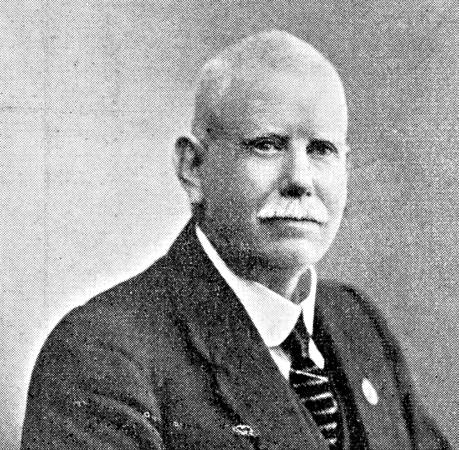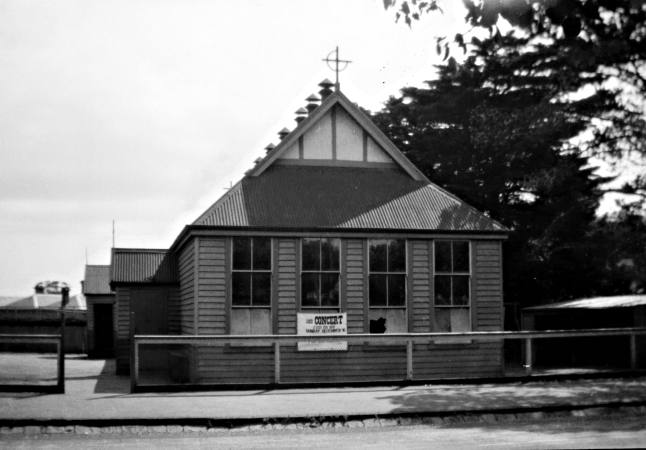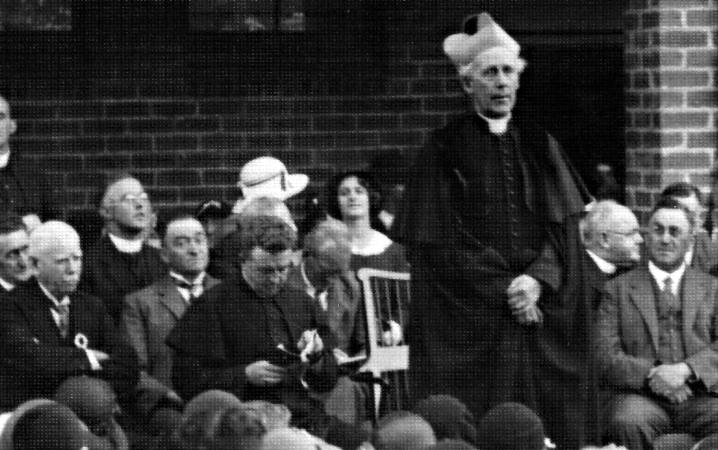John Henry Sheedy: Businessman, Sportsman and Politician

John Henry Sheedy c1940. Courtesy Damian Smith, Kingston Collection.
The histories of many towns pay tribute to the prominent townsmen whose names were associated with almost every movement towards their improvement. One such man, prominent in Mentone’s history, was John H Sheedy.
Arriving in Mentone shortly after the turn of the century, Sheedy very rapidly established himself as a ‘doer’, becoming involved in the development of the fledgling town. His arrival, along with his wife Theresa, daughters Irene and Theresa (Dolly), and son Tom, coincided with that of the Brigidine sisters and the establishment of the new Catholic parish of St Patrick’s Mentone.
On the occasion of Archbishop Carr’s blessing and opening of the convent and school on 7 August 1904, J H Sheedy’s signature is found beside those of long time residents of the district, such as members of the Kelly, Ryan, Hallinan and Dempsey families.

First Catholic Church in Mentone c 1928. Photographer Paul Lemmon, Courtesy Mordialloc & District Historical Society.
Sheedy’s daughter Dolly was a pupil of the Brigidines at the Mentone Convent in its early years. A talented musician, Dolly was the first of many students to enter the Brigidine congregation, becoming Sr Genevieve on her profession at Malvern in January 1918. Irene Sheedy, who with her husband David Simpson conducted a business in Parkdale for many years, was also a pupil at the convent.
At the farewell of Mentone’s first parish priest, Fr Thomas Quinn, in 1914, John Sheedy spoke of building of churches in Mentone, Mordialloc and Chelsea that Fr Quinn had overseen. Over many years he contributed to the Catholic cause in Mentone as ‘a generous helper to St Patrick’s Parish, and for years was looked upon as one of its stalwarts. The Nuns of Kilbreda looked upon him as a reliable friend.’ [1] Sheedy was also very active in local endeavours outside his own church. It is said that ‘every public movement in Mentone always had the help and financial assistance of Jack Sheedy” and that “many people were helped by him unbeknown to anyone’ [2]’ in fact, no public appeal was ever made for a worthy cause from which his name was missing.’ [3]

Opening of St Benedict’s Wing, Kilbreda College, Mentone, by Archbishop Mannix. John Sheedy is seated to the left in the photograph. Courtesy Damian Smith, Kingston Collection.
Sheedy’s long time involvement was diverse, acting as life governor at many of Melbourne’s public hospitals, a trustee of the Cheltenham Cemetery Trust, first President of the Mentone Holy Name Society, active contribution to many sporting clubs including President of Sandringham Bowling Club, Chairman of the Brewers Board and as Chairman of Directors of Standard Newspapers. Appointed sub-editor when the Ould Publishing Company amalgamated with the Frankston Standard, he saw Standard Newspapers through the difficult period of the great depression, becoming manager and editor up until his retirement in 1936. On his deathbed he spoke of how, in his 64 year membership of the Hibernian Australian Catholic Benefit society, he had never drawn one penny sick pay!
Sheedy’s business acumen had developed prior to his coming to Mentone from his native town of Richmond where he had been in the hotel trade all his life. In the early days of the Catholic church in Richmond, Sheedy’s father, John Sheedy senior, had offered ‘a large room at the back of the Richmond Hotel’ [4] of which he was the licensee from 1848-1855 to celebrate Mass. John Sheedy and his siblings had most probably attended school in the ‘small house in Abinger Street, just behind Sheedy’s hotel.’ [5] conducted by Annie Fahey, which also served as a church at times until the building of St James in Bridge Road.
Born in Richmond in 1862, John Henry Sheedy was a foundation member of the Richmond branch of the Catholic Young Men’s Society and was involved in ‘a dramatic club and minstrel troupe formed by members who gave many performances for the church and convent.’ [6] before it was disbanded in 1884.
His interest later turned to politics, with a long period on Richmond Council ‘with two terms as Mayor, the first native to do so.’ [7] When the Duke of Cornwall and York came to Melbourne for the opening of Commonwealth Parliament in 1901, J H Sheedy was honoured to present an illuminated address. It was following a narrow defeat when standing for Parliament that Sheedy decided to sell the Town Hall Hotel in Richmond and make the move to the outer suburbs, purchasing a property called Genazzano in Como Parade East.
However, the name J H Sheedy was much more widely known in lawn bowling circles, a pursuit he had taken up at the Union Club in Richmond in 1887. His expertise in the game was likened to Bradman and Walter Lindrum in an article in the Frankston and Somerville Standard in 1935, which lists his successes in the sport, which were many, winning or placing in championships from local club level to national level in almost every year from 1894 to 1933. ‘One of the greatest – if not the greatest bowler which Australia has produced – the name of Jack Sheedy was known wherever bowlers met.’ [8] The Sheedy home was ‘almost uncomfortably crammed with trophies of every size and description won by him on the bowling green.’ [9]
‘The magnificent cedar sideboard that formerly adored his home and currently stands in the entrance hall at Kilbreda was one of his many trophies.’ [10] The sideboard was awarded to Sheedy for the Australian Open Championship in 1900, one of three national titles. Brigidine Sister Marie O’Kelly suggested that it was rumoured that the sideboard was awarded for second place, which led her to wonder what the winner received!
John Henry Sheedy died aged 81 years in August 1943. His requiem Mass at St Patrick’s Mentone was attended by a very large crowd at both the church and the cemetery, showing the respect the wider community had for him. Students of Kilbreda lined the road sides as the cortege passed by the convent and pallbearers included the Mayor of Mordialloc (Cr E H Davis) and E J Trait (Managing Editor of Standard Newspapers). John Sheedy was buried with his wife Theresa, who had predeceased him in 1935, at the Pioneer Cemetery in Cheltenham, not far from the graves of the Brigidine Sisters.
Footnotes
- Frankston Standard, 20 August 1943 page 3.
- Frankston Standard, ibid.
- Frankston Standard, op.cit.
- Mackle, F. Footprints of our Catholic Pioneers, 1942.
- Ebsworth W., Pioneer Catholic Victoria, 1973 page 312.
- Ebsworth W., ibid, page 326.
- Lane P., & Johnston S., St Patrick’s: The Mission of Mentone page 45.
- Frankston Standard, op.cit.
- Frankston Standard, op.cit.
- Underwood, M., A View from the Tower, 2004, page 27.
